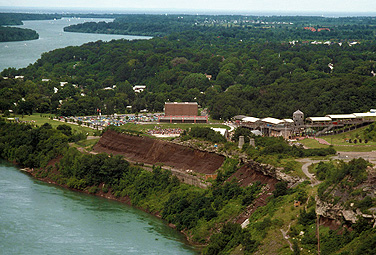News
Exhibition recalls innovative Artpark summer residency program

Located along the Niagara Gorge seven miles downriver from Niagara Falls, Artpark was the site of the innovative Visual Arts Program. Photo: UB ART GALLERY
The seminal years of the innovative Visual Arts Program at Artpark, the New York State park located along the Niagara Gorge in Lewiston, are the focus of a UB Art Gallery exhibition opening on Sept. 25.
“Artpark: 1974-84” will run from Sept. 25 through Dec. 18 in the gallery in the Center for the Arts, North Campus. An opening reception will be held from 2-6 p.m. Sept. 25 in the gallery. Both the exhibition and reception are open to the public.
The exhibition covers the halcyon days at Artpark, when “earth artist” Charles Simonds built tiny villages of mud and clay all over his own body (wherein dwelled mythical “little people”), as well as life-sized cairns; off-beat plays took place each day in tiny woodland theaters; and Spanish food artist Antoni Miralda organized a procession and feast marking the end of the summer leisure.
Children and adults alike took workshops in clothing design and cooking, contributed items to Ant Farm’s Oldsmobile station wagon time capsule, scampered up pyramids made by Lloyd Hamrol from dirt-filled burlap bags and descended into the earth by way of a sculpture of concentric rings constructed by Mary Miss.
They wandered among media and sound installations, and cavorted in a forest clothed by Pat Oleszko in vividly colored, Cheshire-cat-striped fabrics and through a field of Joan Zalenski’s ceramic Holsteins.
There were spectacular earthworks by such artists as George Trakas, Michelle Stuart and Dennis Oppenheim, and mysterious and unexpected site-specific structures like Robert Stackhouse’s snaking A-frame that followed the contours of the Niagara River at the edge of the gorge.
Artpark was the site of hundreds of quirky, complex, brilliant, challenging works of art intended to last a short time and engage visitors with the works, and the artists who produced them. It was radical and provocative. It was fun.
Curated by Sandra Q. Firmin of the UB Art Gallery, the exhibition and its accompanying catalogue examine the place of the Artpark Visual Arts Program in American art during the 1970s and 1980s, contextualizing it as a radical experiment in temporary public art within the history of sculpture parks in the United States and the flowering of alternative art spaces in the 1970s.
The project focuses on specific works as they relate to larger developments, such as site-specificity, the confluence of architecture and sculpture, new media within the public realm and the 1970s women’s movement.
The exhibition features documentation of more than 200 artists’ projects, photographs, drawings, maquettes, video and film, ephemera, multimedia installations, and original and re-fabricated sculpture and installations.
The catalogue features six essays, a chronology of projects, schematic drawings, excerpts of artist statements and extensive documentation of projects. While photos of all the works completed at Artpark have been reproduced in black and white, this is the first time that many of them are presented in color.
Firmin says the exhibition/catalogue presents the first historical chronicle of the Artpark Visual Arts Program, which she calls “a radical experiment in artist-public interaction and site-specificity that successfully balanced a populist mission with the creation of experimental art.”
“Many of the artists who were part of Artpark’s early years were beginning careers that stretched the boundaries of what could be considered art and have since become internationally recognized in the realms of conceptual art, performance art, sound art, architectural sculpture, media arts and earthworks,” she says.
She points out that Artpark—sensitive to the lack of opportunities for women and ethnic and racial minorities in the visual arts at the time—invited a notable number of women and artists of diverse ethnic and racial backgrounds to participate in the residencies.
“The sheer number of prominent and less-known artists who worked in this program will mark ‘Artpark: 1974-84’ as a primary source on this period of American art,” Firmin says.
Artpark was founded in 1974 as a seasonal, outdoor, cultural New York State park. The 172-acre park, situated on the U.S.-Canada border seven miles downriver from Niagara Falls, provided artists with a spectacular setting in which to work, live and draw inspiration—featuring as it did theaters, open land for artist projects, wooded areas, trails to the Niagara River and a communal elevated boardwalk known as the ArtEl.
“Mindful of the land’s varied histories, artists often developed projects in response to its mythical and geological pasts,” Firmin says, “as well as to traces of human presence as evidenced by such things as a landfill known as the ‘spoils pile,’ a chemical disposal site, fragments of an earlier railroad and bridge, a portage trail and an ancient Native American burial ground.”
Support for the catalogue is provided by a grant from the Henry Luce Foundation. Additional support for the exhibition and publication is provided by the Andy Warhol Foundation for the Visuals Arts and the National Endowment for the Arts, with programming support from the Niagara Falls Bridge Commission and UB’s Department of Visual Studies, Poetry Collection and School of Architecture and Urban Planning.

Reader Comments